
AMD Radeon RX 580 and RX 570 Review: The Best Graphics Cards For 1080p Gaming
Introduction
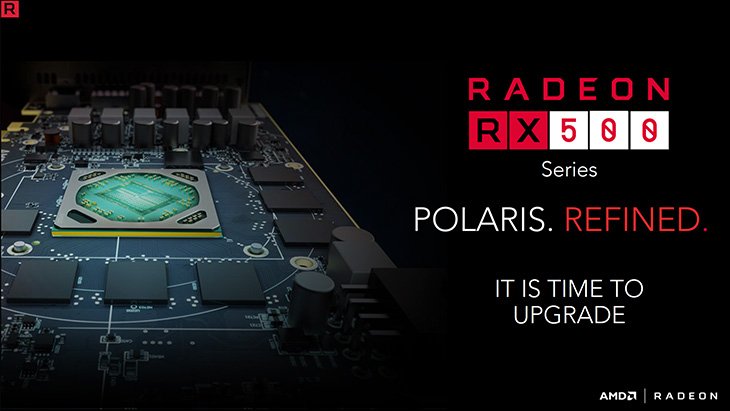
The launch of the RX 500 series is based on refined versions of the Polaris 10 and 11 architectures with the exception of the RX 550 which is based on a new Polaris 12 chip. In the RX 500 series, we have the RX 580, RX 570, RX 560, and RX 550 and the prices will be from $79 and up to $229. Today, we will be looking at the RX 580 and RX 570 that retail at $230 and $170. We have already covered the AMD Radeon RX 550 in-depth and we were blown away by its top notch gaming performance against Intel's HD 630 iGPU. If you are a gamer that mostly plays eSports titles or want a low profile card for your HTPC, I strongly recommend considering getting the RX 550.
Now, something that I have noticed with the release of the RX 500 series is that many people are bashing AMD for rebranding the RX 400 series which I understand where they are coming from but they are forgetting that the RX 500 series was designed specifically for gamers who are on a 2 year old graphics card and have not made the move to 14nm technology. AMD has specifically said that the RX 500 series is not aimed at gamers who already have an RX 400 series card and that's why they are not comparing the two. The RX 500 series is meant mostly for people with older graphics cards such as the Radeon 300/200 or GTX 900 series. If you already have a RX 400 series card then the RX 500 series cards are not for you, it's that simple.
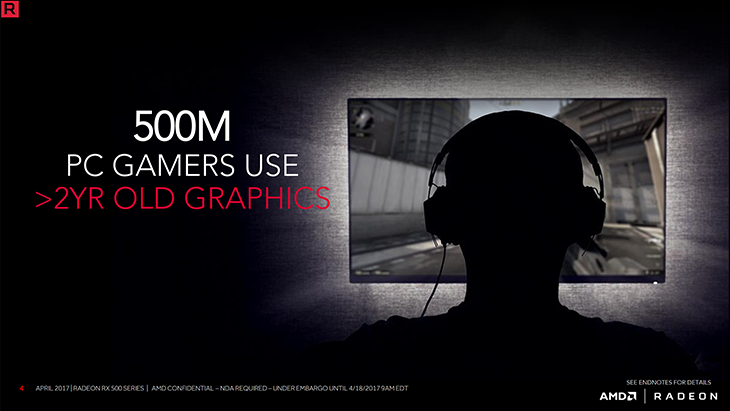
According to AMD, more than 500 million PC gamers are using greater than 2 years old graphics cards and these people will benefit greatly by upgrading to 14nm technology. AMD says that the Radeon RX 570 is aimed at 60FPS 1080p gaming and is as much as 2.3X faster than the R7 370. AMD also claims that the RX 580 is up to 57 percent faster versus the R9 380X, and is capable of achieving over 60FPS at 1440p in several titles. The Radeon RX 580 and RX 570 come with many modern features and capabilities found in other Radeon RX 500 series products such as Free Sync, HDMI 2.0, DP 1.4 HBR, HEVC 4K decoding, Radeon Chill, Radeon ReLive, and much more.
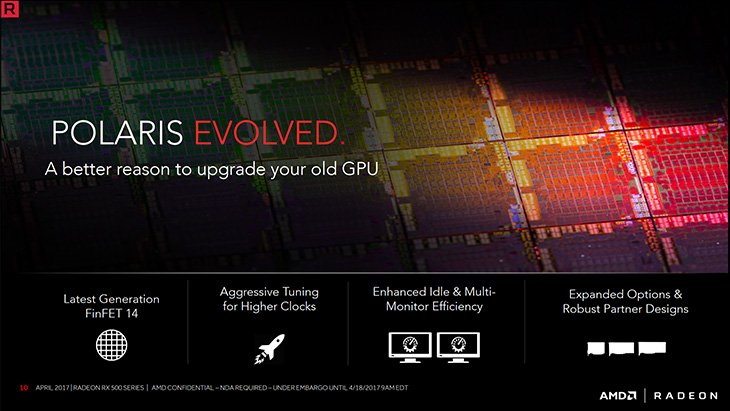
It seems that AMD has done away with the reference design in the RX 500 series so it will all be custom-design cards through AMD's add-in board (AIB) partners. Since there won't be any reference-design cards in the market, prices will be higher than the MSRP, but also the performance will be much better. AMD has positioned the Radeon RX 580 to compete against the GTX 1060 while the RX 570 is positioned to compete against the GTX 1050 Ti.
If you are a gamer that is still running a Radeon R9 380 or GTX 970 then there's really no reason not to upgrade to a RX 580/RX 570 or GTX 1060/GTX 1050 Ti at this point. Although, keep in mind that with the RX 580/RX 570 you have the option for crossfire for an additional boost. Whereas with the GTX 1060/GTX 1050 Ti, there is no SLI support. NVIDIA has disabled SLI support from everything below the GTX 1070. Also, another thing to consider is that AMD is ahead of NVIDIA in drivers and newer games support and AMD's cards get much better with time compared to Nvidia's cards.
Specifications
| AMD Radeon RX 500 Series Lineup | ||||
|---|---|---|---|---|
| Model: | Radeon RX 550 | Radeon RX 560 | Radeon RX 570 | Radeon RX 580 |
| Process Node: | 14nm FinFET | 14nm FinFET | 14nm FinFET | 14nm FinFET |
| GPU Model: | Polaris 12 (Lexa Pro) | Polaris 21 (Baffin Pro) | Polaris 20 XL (Ellesmere Pro) | Polaris 20 XLX (Ellesmere XT) |
| Architecture: | 4th Gen GCN | 4th Gen GCN | 4th Gen GCN | 4th Gen GCN |
| Cores: | 512 | 1024 | 2048 | 2304 |
| Base Clock: | 1100 MHz | 1090 MHz | 1168 MHz | 1257 MHz |
| Boost Clock: | 1183 MHz | 1287 MHz | 1244 MHz | 1340 MHz |
| Compute Units: | 8 | 16 | 32 | 36 |
| Memory Clock (Effective): | 1750 (7000) MHz | 1750 (7000) MHz | 1750 (7000) MHz | 2000 (8000) MHz |
| Computing Power (FP32): | 1,126 GFLOPS | 2,232 GFLOPS | 4,784 GFLOPS | 5,788 GFLOPS |
| Memory Size: | 2GB GDDR5 | 2GB GDDR5 | 4GB GDDR5 | 8GB GDDR5 |
| TDP: | 50W | 80W | 150W | 185W |
| Memory Bus Width: | 128-bit | 128-bit | 256-bit | 256-bit |
| Memory Bandwidth: | 112 GB/s | 112 GB/s | 224 GB/s | 256 GB/s |
| Interface: | PCIe 3.0 x8 | PCIe 3.0 x8 | PCIe 3.0 x16 | PCIe 3.0 x16 |
| Transistors: | 2.2 Billion | 3 Billion | 5.7 Billion | 5.7 Billion |
| Die size: | 101 mm² | 123 mm² | 232 mm² | 232 mm² |
| TMUs: | 32 | 64 | 128 | 144 |
| ROPs: | 16 | 16 | 32 | 32 |
| Pixel Rate: | 18.93 GPixel/s | 20.40 GPixel/s | 39.8 GPixel/s | 42.9 GPixel/s |
| Texture Rate: | 37.9 GTexel/s | 81.6 GTexel/s | 159.2 GTexel/s | 193.0 GTexel/s |
| Price: | $79 | $99 | $169 | $229 |
| Release Date: | April 20, 2017 | May ???, 2017 | April 18, 2017 | April 18, 2017 |
The Radeon RX 580 is built using the Polaris 20 XLX GPU, code-named Ellesmere XT and it is based on a 4th gen GCN architecture while the RX 570 is built using the Polaris 20 XL GPU which is basically just a slightly cut down variant known as Ellesmere Pro. Basically, think of the Polaris 20 GPU as a slightly overclocked Polaris 10 GPU. The transistor count and die size remains the same so the transistor count is 5.7 billion and the die measures 232 square millimeters. The RX 580 has a 185W TDP, a full 256-bit memory bus, and a 1257 MHz base and a 1340 MHz boost. On the other hand, we have the RX 570 which has a 150W TDP, also a 256-bit memory bus, and a 1168 MHz base and a 1244 MHz boost.
AMD has equipped the RX 580 with 36 Compute Units, 144 TMUs, and 32 ROPs while the RX 570 comes with 32 Compute Units, 128 TMUs, and the same amount of ROPs as the RX 580. All the RX 500 series support features such as Radeon Chill which is a gameplay adaptive power saving feature, Radeon ReLive which can be used to capture, stream and share your greatest moments, AMD FreeSync Technology, and also AMD Eyefinity Technology.
The Cards
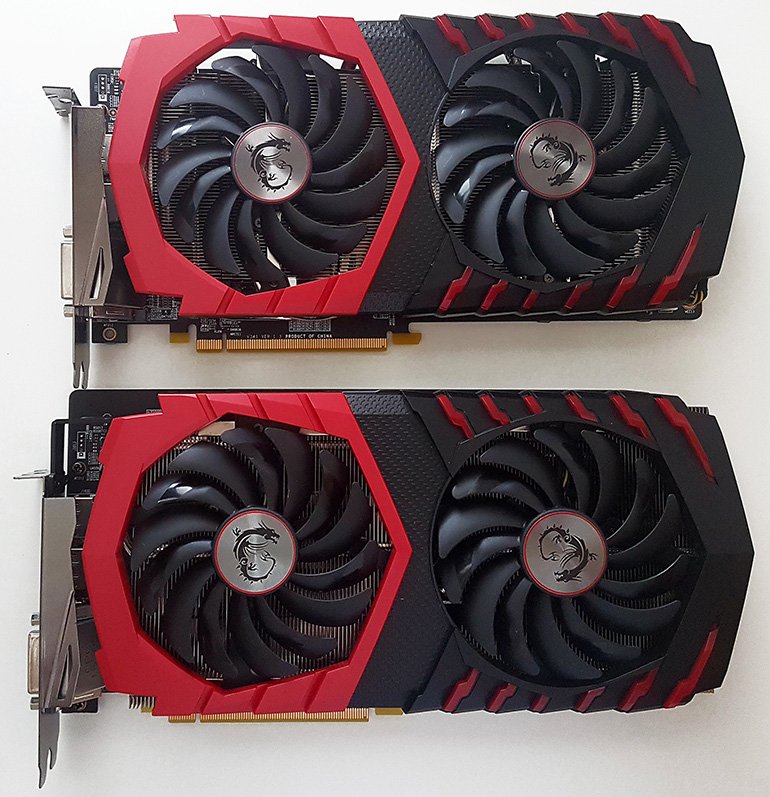
AMD has sent us the MSI RX 570 4GB Gaming X card (Top) and the MSI RX 580 8GB Gaming X model (Bottom) for this review. Both the MSI cards come with a slight factory overclock which shouldn't make too much of a difference in performance. With factory overclocked cards, keep in mind that you're often paying for a better cooler rather than for the factory overclock. The MSI Gaming App will allow you to have full control over the speed of your card by giving you the option of choosing between three modes: OC, Gaming, and Silent. The MSI RX 580 has a boost clock of 1393 MHz in OC Mode, 1380 MHz in Gaming Mode, and 1340 MHz in Silent Mode and the MSI RX 570 has a boost clock of 1293 MHz in OC Mode, 1281 MHz in Gaming Mode, and 1244 MHz in Silent Mode.
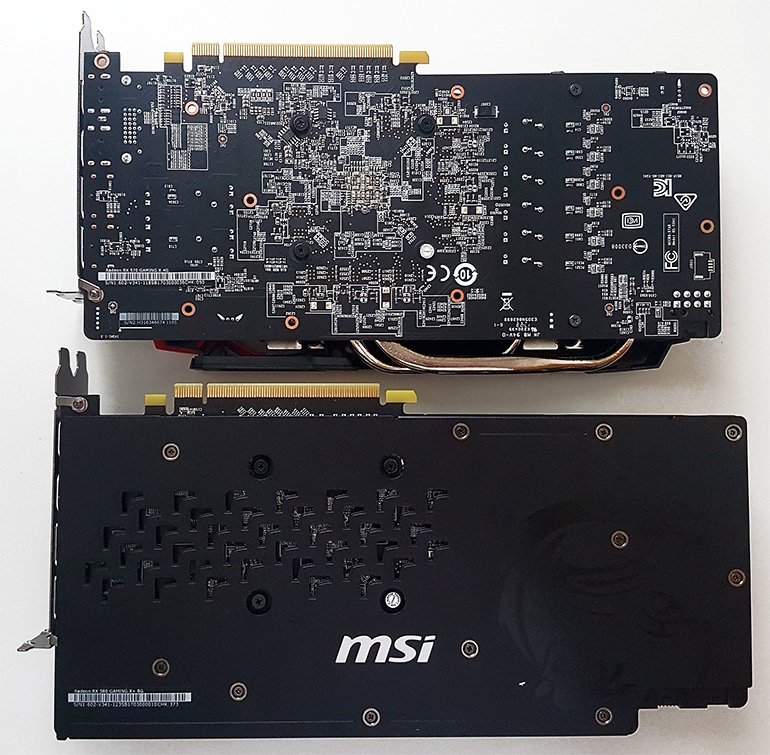
As far as dimensions go, the MSI RX 570 card measures 276mm long, 142mm tall, and 39mm wide and it weighs around 778g. The MSI RX 580 on the other hand is slightly wider and heavier, it's 42mm wide and weighs 978g. Both the MSI cards come with three display outputs, two HDMI 2.0b ports, a Dual-Link DVI port, and two DisplayPort 1.4.
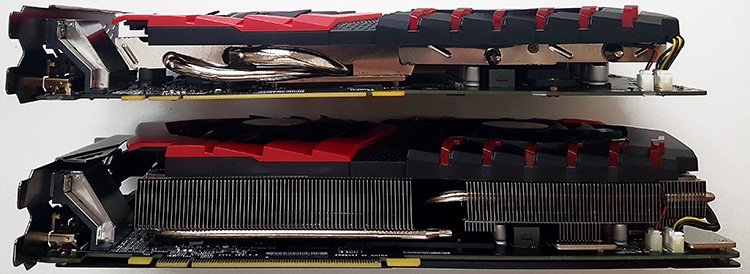
There are two models of the MSI RX 580 Gaming X card, a 4GB and an 8GB model. The 4GB model requires a 1 x 8-pin power connector while the 8GB model needs a 2 x 8-pin power connector. The MSI RX 570 on other hand just needs a 1 x 8-pin power connector. Looking at the MSI RX 580, we can see that it features a matte black PCB and both cards utilize the company's TwinFrozr VI cooler design. These cards are a dual-slot solution, and are cooled by a nickel-plated copper base plate with 8mm heat pipes.
Test Setup
| Test Setup | |
|---|---|
| Processor: | AMD Ryzen 7 1700X |
| Motherboard: | MSI X370 xPower Gaming Titanium (BIOS Version 1.6) |
| RAM: | Crucial Ballistix Elite 2933MHz DDR4 16GB (2x8GB) |
| Graphics Card: | MSI Radeon RX 580 8GB Gaming X MSI Radeon RX 570 4GB Gaming X MSI GeForce GTX 1060 6GB Gaming X MSI GeForce GTX 1050 TI 4GB Gaming X |
| Storage: | Crucial MX300 1TB SSD |
| Power Supply: | SilverStone Titanium ST80F-TI 800W |
| Case: | Open ATX Bench Case |
| OS: | Windows 10 64Bit |
| Thermal Compound: | Noctua NT-H1 |
| Heatsink: | Noctua NH-D15 |
Since the Radeon RX 580 and RX 570 are mid-range cards, testing will be conducted by comparing them against the NVIDIA GTX 1060 and GTX 1050 Ti to see who offers the best gaming performance. We have decided to use the Ryzen 7 1700X running at stock settings because it's a fantastic processors that offers excellent gaming performance at a much cheaper price compared to the competition. We also want to eliminate any CPU bottleneck as much as possible and the Ryzen 7 1700X can handle anything you throw at it.
All of the testing is done with an ambient temperature of ~22C and the processor has the power saving features disabled in the BIOS. Also, the testing was done on a fresh install of Windows 10 64-bit and we made sure there were as few processes running as possible by disabling a bunch of unnecessary services that come with Windows 10.
In gaming, we will be testing some games at 1080p and 1440p and the settings will be set to high or max depending on how demanding the game is.
Idle temperature will be measured after leaving the computer idle for 20 minutes with no additional applications running in the background and
load temperature will be measured by playing GTA V on very high/ultra settings for 20 minutes at 1440p.
Gaming Benchmarks:
+ Ashes of the Singularity
+ Deus Ex Mankind Divided
+ Ghost Recon Wildlands
+ Battlefield 1
+ Far Cry Primal
+ GTA V
+ Hitman 2016
+ Watch Dogs 2
+ The Witcher 3
Temperature

When measuring temperatures, you have to account for margin of error which is usually 1-2 degree Celsius.
We are using all MSI graphics cards for this review and since they all share similar cooler design, they all run relatively cool in idle mode.
When leaving the computer at complete idle, the MSI RX 580 and RX 570 idle at around 32-33 Celsius.
When playing GTA V on very high/ultra settings at 1440p, the temperature of the MSI RX 580 and RX 570 jumps to around 67 and 64 Celsius, respectively.
Once I got out of GTA V, the temperature of both cards dropped back down to around 34-35 C within a few minutes.
Gaming Performance Results
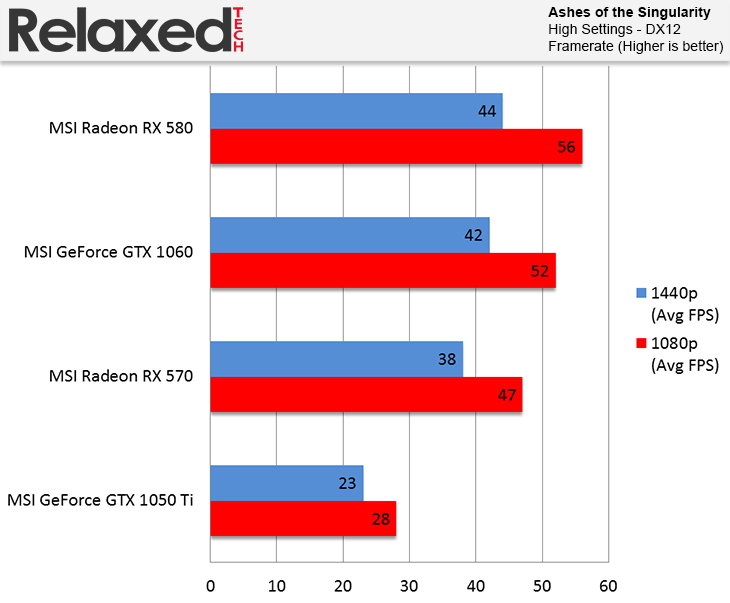
Looking at the Ashes of the Singularity benchmark, the RX 580 and RX 570 outperformed their main competitors at both 1080p and 1440p.
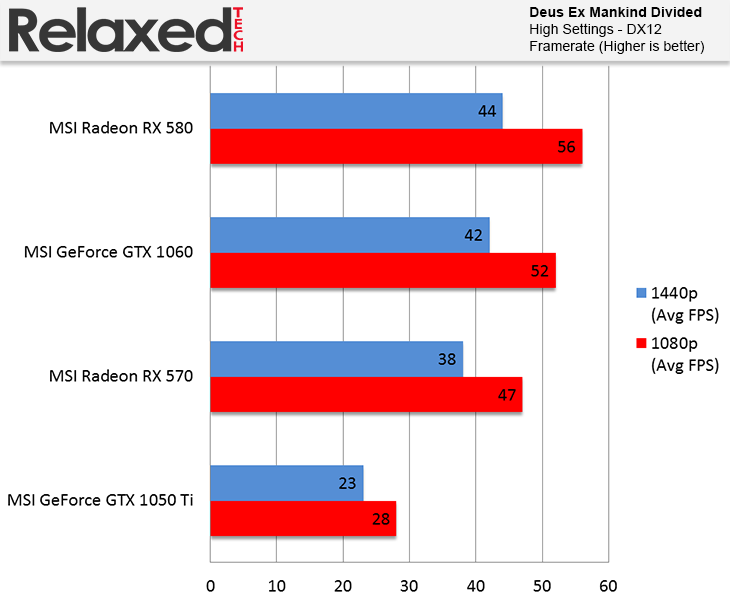
In Deus Ex Mankind Divided, the RX 580 and RX 570 offered much better gaming performance than the GTX 1060 and GTX 1050 Ti.

Moving on to the Ghost Recon Wildlands, the GTX 1060 performed slightly better than the RX 580 at 1080p and also 1440p.
The RX 570 keeps crushing the GTX 1050 Ti so far.
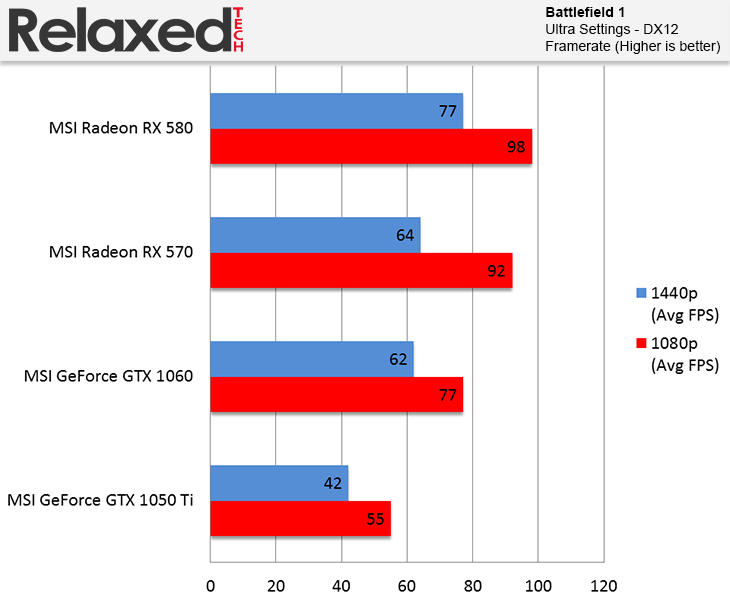
In Battlefield 1, the RX 580 and RX 570 obliterated the GTX 1060 and GTX 1050 Ti and even the RX 570 outperformed the GTX 1060.
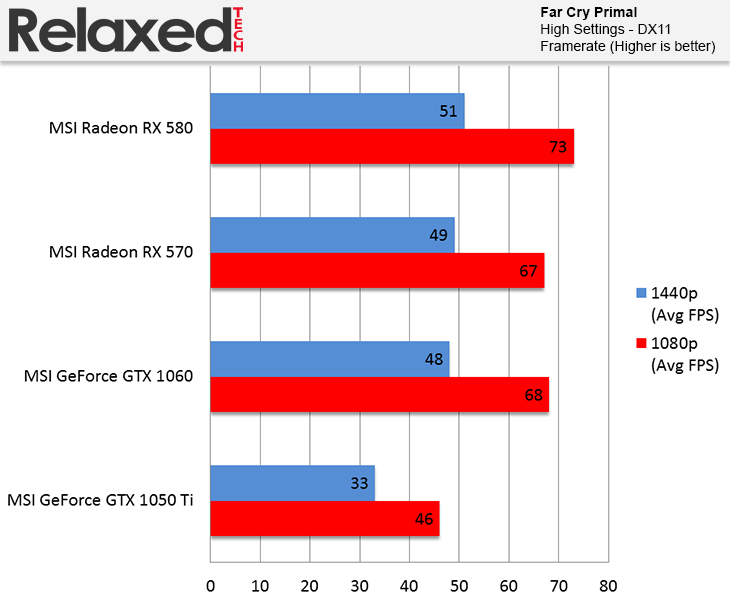
Once again we see the RX 580 and RX 570 wreck their main competitors at both resolutions in Far Cry Primal.
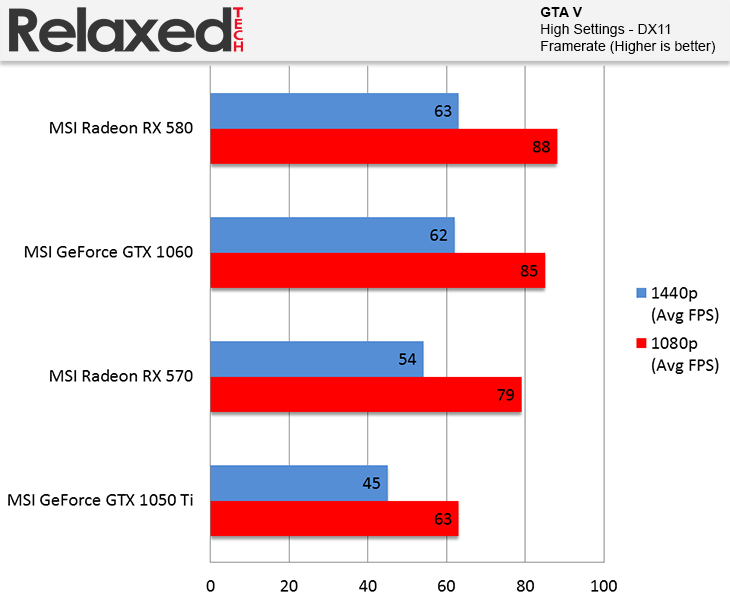
Moving on to GTA V, the Radeon RX 580 performed better than the GTX 1060 while the RX 570 destroyed the GTX 1050 Ti at both resolutions.
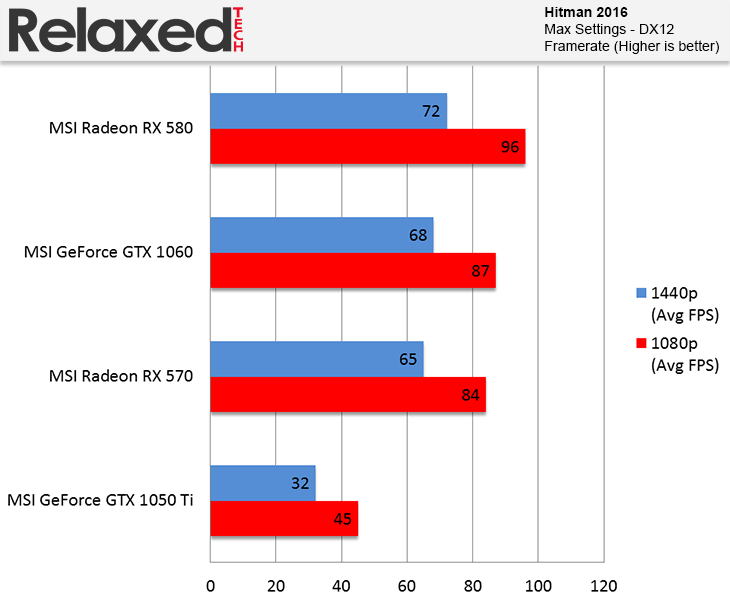
In Hitman 2016, the RX 580 and RX 570 decimated the GTX 1060 and GTX 1050 Ti in 1080p and also 1440p.
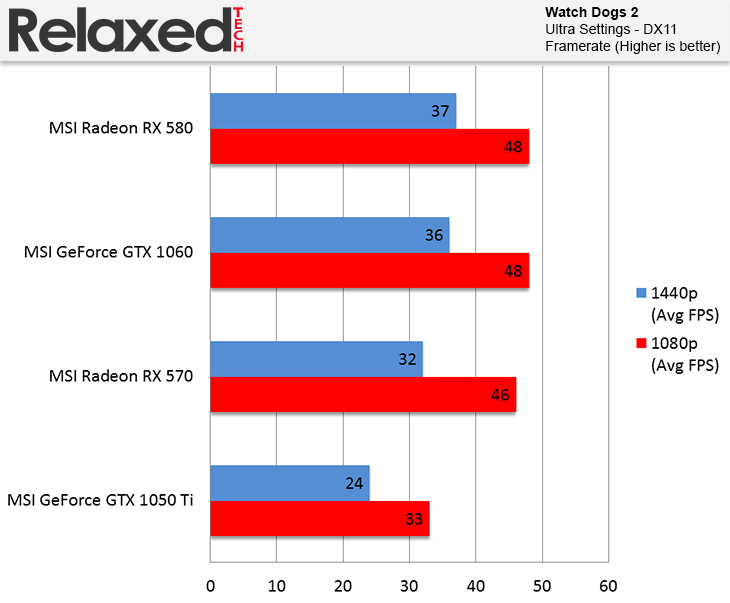
In Watch Dogs 2, the RX 580 and GTX 1060 performed on par while the RX 570 nuked the GTX 1050 Ti.
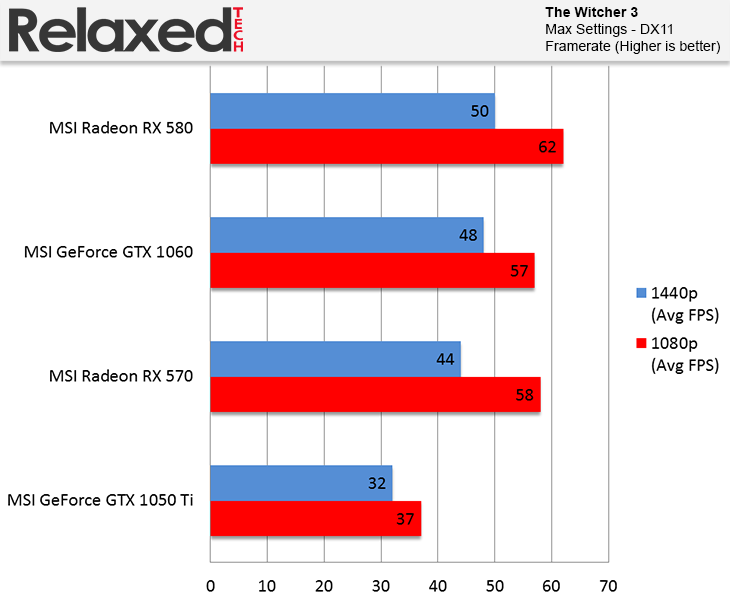
Last but not least, the RX 580 and RX 570 once again crushed their main competitors in The Witcher 3.
Value & Conclusion
The Radeon RX 580 and RX 570 offer superb gaming performance in many popular DX11 and DX12 titles and outperform each of their main competitors across a wide range of AAA games. The RX 570 is substantially faster than the GTX 1050 Ti and the difference between the two is night and day. The RX 570 is more than capable of achieving 60FPS at 1080p with high settings and the RX 580 can easily handle some games at 1440p at med-high settings at 60FPS+. I found the RX 580 to be much faster than the GTX 1060 in pretty much every game that I tested.
If you are running an older graphics card such as the R9 370/380 or GTX 950/970, the RX 570 and RX 580 provide an excellent upgrade path and the FreeSync gaming displays are much cheaper than Nvidia's G-Sync displays. The RX 570 delivers amazing 1080p gaming performance which easily surpasses the GTX 1050 Ti and even rivals the GTX 1060 in some titles. Anyone who is looking to purchase a GTX 1050 Ti should definitely consider the RX 570 because it's a much more stronger card.
The RX 580 and RX 570 come with many modern technologies such as Free Sync, HDMI 2.0, DP 1.4 HBR, HEVC 4K decoding, Radeon Chill and Radeon ReLive.
If you are building a budget friendly gaming rig and want a strong mid-range card for 1080p+ gaming, the RX 580 and RX 570 are more than capable of maxing out any game at 60FPS 1080p.
The MSI RX 580 and RX 570 Gaming cards run relatively cool at 32 Celsius in idle mode and stay under 70 Celsius in heavy gaming.
Pros:
+ Fantastic 1080p Gaming Performance
+ Supports Modern Technologies
+ Large Factory Overclock
+ Faster Than Competition
+ Runs Quiet and Cool
Cons:
- MSI RX 580 Needs 2 x 8-pin Connectors
My only issue with the MSI RX 580 8GB Gaming X is that it needs a 2 x 8-pin power connector. It does not make any sense for the RX 580 to require a 2 x 8-pin power connectors when the RX 480 only needed a single 8-pin connector. Other than that, the RX 580 and RX 570 are fantastic cards that perform exactly as advertised. As far as pricing goes, the MSI RX 580 8GB Gaming X seems to retail for about the same as the MSI GTX 1060 6GB Gaming X so the MSI RX 580 is the clear winner between the two. The MSI RX 570 4GB Gaming X is about $40 more than the MSI GTX 1050 Ti 4GB Gaming X but you have to keep in mind that the RX 570 is a much stronger video card than the GTX 1050 Ti and sometimes it can perform on par with the GTX 1060 in some titles. With all that being said, the Radeon RX 580 and RX 570 deserve our Elite Award.
Final Score 9.2
